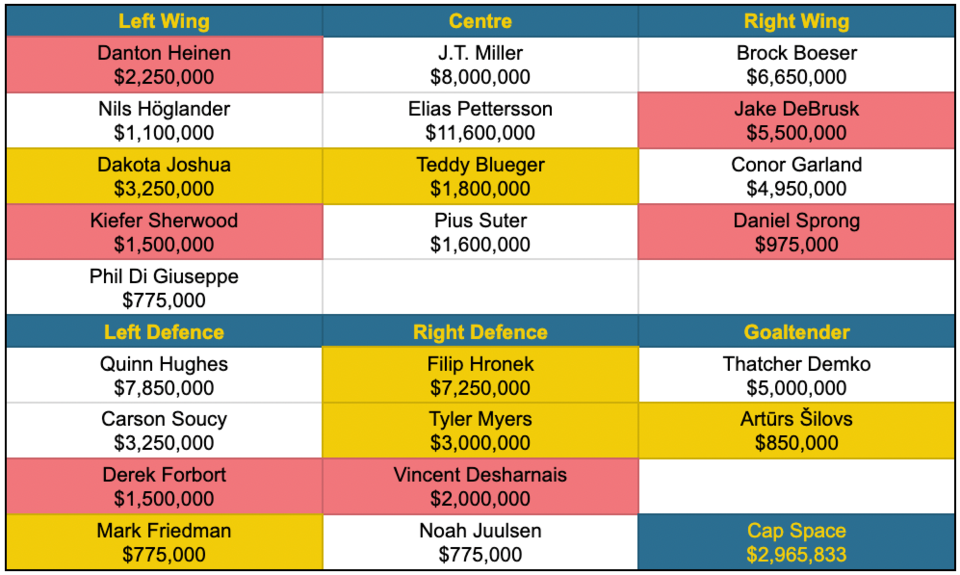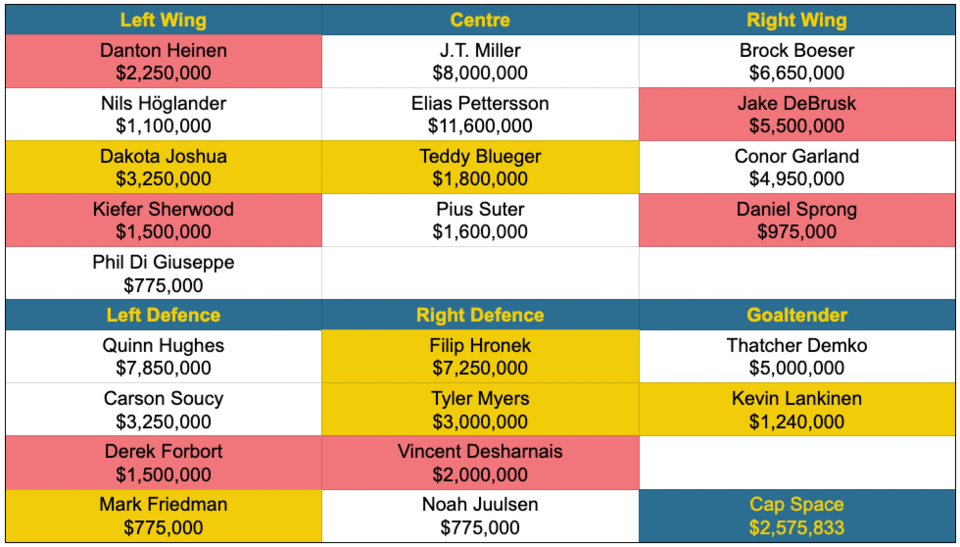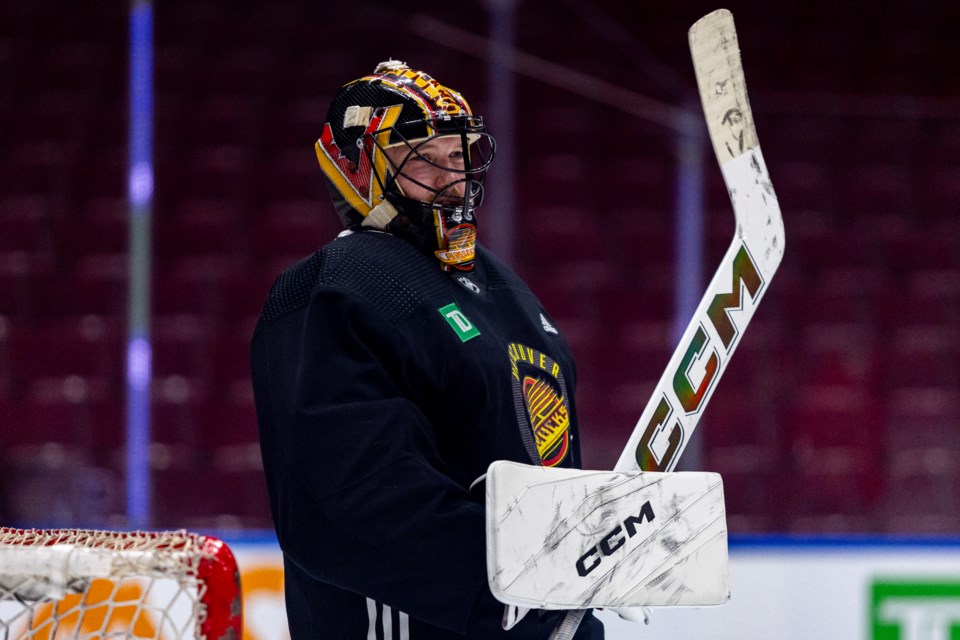Things were going so well.
The offseason has largely been kind to the �鶹��ýӳ��Canucks, who dealt with some difficult negotiations with their restricted free agents, figured out a way to trade Ilya Mikheyev, made some savvy bets with few picks at the NHL Entry Draft, and filled key roster needs in free agency with some reasonable contracts and intriguing additions.
Yes, they lost Vasily Podkolzin along the way, trading him to the Edmonton Oilers for a fourth-round pick, but even that was arguably a savvy move, as they cut their losses with a prospect rather than waiting until he had no value at all. Podkolzin had his chance to prove himself to the Canucks last season and he fell short.
Everything was going swimmingly, particularly in regards to the salary cap. After years of starting the season in LTIR, the Canucks finally had enough cap space to fit Tucker Poolman’s $2.5 million contract, allowing them to accrue cap space during the season, which would potentially giving them more room to maneuver in the trade market.
But was the Canucks' offseason too good to be true?
Thatcher Demko could miss the start of the season
Less than a month before the start of training camp, a new wrinkle has developed that could cause some salary cap complications. According to Chek TV’s Rick Dhaliwal and The Athletic’s Thomas Drance, Thatcher Demko , with even the start of the regular season in doubt, something , who said, "No one is really sure about his timeline."
“The club is hopeful that its Vezina Trophy finalist will be available to play on opening night — Oct. 9 against the Calgary Flames — but even that seems to be in question at this late stage of the summer,” said Dhaliwal and Drance.
That came as a surprise considering there was considerable buzz back in May that Demko if the Canucks had been able to extend their postseason. Of course, pushing for a return in the playoffs is different than setting yourself up for a full season of success in the regular season.
Demko suffered a knee injury in Game 2 of their first-round series against the Nashville Predators, just four games after returning from another knee injury suffered earlier in the season. This is very concerning considering this is now back-to-back seasons with Demko suffering a significant injury.
A groin injury limited Demko to just 32 games during the 2022-23 season, as an initial six-week timeline ballooned into 12 weeks out of the lineup. Keeping Demko healthy next season will be essential, both because no one wants him to get hurt again and also because Demko is key to the Canucks’ hopes of not just repeating last season’s performance but improving on it.
With that in mind, if Demko is taking a more cautious approach with his injury rehab this offseason, that’s probably a good thing.
When Demko made his return in the penultimate game of the regular season, he used the word “aggressive” to describe his approach to getting back in the lineup. He said he felt “super confident” in his return from injury and that he and the Canucks’ training staff had been “working around the clock” to get him ready before the start of the playoffs.
Considering he almost immediately injured the same knee, you have to wonder if that approach was too aggressive.
Of course, taking that aggressive approach made sense given the high stakes of the playoffs; there’s far less of a rush to get back for training camp, the preseason, or even the start of the regular season. The most important thing is getting Demko back to 100 percent and hopefully look to prevent further injuries in the coming season.
That likely also means lessening his workload.
Demko had a heavy workload last season, starting 51 games of the 68 he was available to play. That’s a 62-game pace over a full season. Just three goaltenders started 60 or more games last season: Juuse Saros, Alexander Georgiev, and Connor Hellebuyck.
That used to be a normal workload for a starting goaltender but the wear and tear of modern goaltending techniques has made that more of a rarity. The human body is simply not meant to move the way goaltenders routinely move during games.
Notably, starting that many games seemed to have a deleterious effect on Saros, Georgiev, and Hellebuyck. In the playoffs, all three had a save percentage at or below .900, with the Vezina-winning Hellebuyck seeing the sharpest dropoff, going from a sparkling .921 save percentage in the regular season to a dreadful .870 in the postseason.
So, it makes perfect sense for Demko to take his time returning to action and to have an easier workload when he does return, as much as that will likely pain the ultra-competitive goaltender. The trouble is, that potentially throws a wrench into the Canucks’ carefully-constructed salary cap structure.
Can the Canucks add a goaltender while staying out of LTIR?
Let’s break this down. With Podkolzin traded to the Oilers, the Canucks have a pretty clear path to their 23-man roster based on players who are waiver eligible, with Arturs Silovs the lone exception.

This 23-man roster leaves the Canucks with $2,965,833 in cap space — plenty of room for Tucker Poolman’s $2.5 million cap hit, with $465,833 available to start accruing.
If Demko isn’t available for the start of the season, however, that complicates things. The Canucks would either need Nikita Tolopilo or Jiri Patera on the NHL roster or would need to add another goaltender.
The Canucks can’t fit Tolopilo or Patera on the roster as is — $465,833 is not enough space for either Tolopilo’s $950,000 or Patera’s $775,000 cap hit — but putting Mark Friedman on waivers and assigning him to the AHL if he clears would do the trick.
On the other hand, that would mean starting the season with a very green goaltending tandem that would have, at most, 27 games of NHL experience. It’s understandable, then, that the Canucks would be looking to add someone with a bit more NHL experience under his belt.
According to Dhaliwal, the Canucks are targeting Kevin Lankinen, who is really the only remaining free-agent goaltender who would make any sort of sense to sign. The 29-year-old had a respectable .908 save percentage as a backup with the Nashville Predators last season.
The question is, can the Canucks fit Lankinen under the cap without having to put Poolman on LTIR?
Well, yes. Maybe. It depends.
A lot of it depends on what kind of contract Lankinen can command at this point in free agency. His contract projection from ahead of July 1 predicted a two-year deal with an average annual value of $2.024 million, which is essentially the same cap hit as his last contract with the Predators.
With the frenzy of free agency long in the rearview mirror, however, Lankinen would presumably be more willing to accept a cheaper deal, much like Daniel Sprong signed with the Canucks for $975,000 rather than the $3-4 million he was projected to receive.
On the other hand, Lankinen could gamble that other teams, like the Canucks, could find themselves in a bind at training camp or the preseason due to injuries and need to sign the best free-agent goaltender available.
So, how much cap space can the Canucks conceivably clear up to potentially sign Lankinen? It depends on how many players they want to risk losing to waivers and how willing they are to start the season with a shorthanded roster.
The Canucks could put Friedman, Noah Juulsen, and Phil Di Giuseppe on waivers to start the season, taking the chance that none of them will be claimed in the mass of other players around the league going on waivers near the start of the season. That would leave the Canucks with a 20-man roster — .
Each of those three players are on a league-minimum deal with a cap hit of $775,000, so that move would clear $2.325 million in cap space, which can be added to the $465,833 they already have available for around $2.79 million in theoretical cap space to sign Lankinen.
Alternatively, they could waive just two of those players to have a little over $2 million in cap space or just one of those players to have around $1.24 million in cap space.
According to Dhaliwal and Drance, the Canucks have reportedly made an offer to Lankinen. From a purely conjectural standpoint, one might guess that the offer had an average annual value of around $1.24 million. In theory.
In the hypothetical world where Lankinen signed for the Canucks for $1.24 million, he would presumably stay with the Canucks as their backup goaltender once Demko returned to the lineup, sending the waiver-exempt Silovs back to the Abbotsford Canucks. Conveniently, that particular theoretical cap hit would still leave the Canucks with just enough cap space to avoid putting Poolman on LTIR, even with a full 23-man roster.

The Canucks showed last season that they have no issues playing fast and loose with their roster size to make things work under the cap. They played opening night with just 11 forwards. It worked out pretty well — the Canucks, led by Brock Boeser’s four goals, thrashed the Edmonton Oilers and were subsequently able to call up Jack Studnicka from the AHL without a cap hit under emergency conditions.
Of course, if Lankinen isn’t willing to sign at that cap hit, then the Canucks might have to consider other options. Other goaltenders might hit the waiver wire during training camp and the preseason or they could make a trade to bring in a backup goaltender as they did with Casey DeSmith last season.
All that is to say, it’s a solvable conundrum, but one that’s a little bit more complicated than if Demko could be comfortably relied upon to play on opening night.



